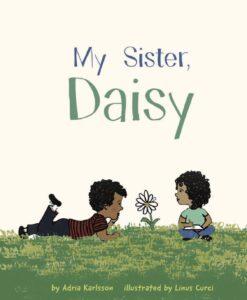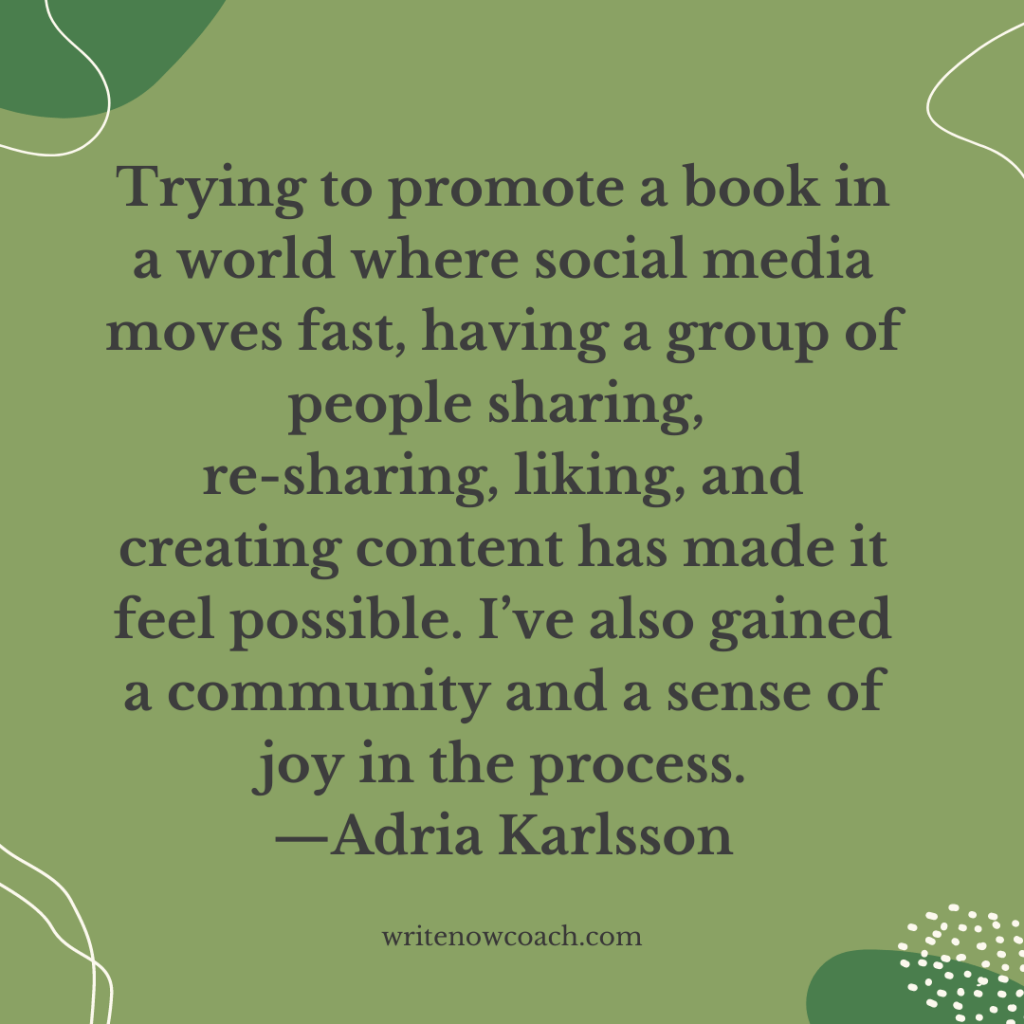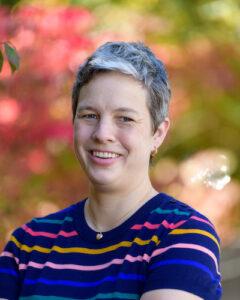From Personal Story to Picture Book
August 31, 2021
Note From Rochelle
Dear Writers,
Are you writing? With all the drama in the world—and in our lives—it’s difficult to focus. In last week’s blog post, I talked about how we can overcome distraction, focus on a task, and write. (But that’s not always easy.
In my ADHD coach training class, I learned that PAUSING can be a powerful tool. Now when I’m writing and feeling distracted, tempted to hop over to Twitter or Facebook—I pause. I ask myself, “Do you really want to do this?” Usually, the answer is no. I take a few deep yoga breaths, stretch, and get back to work. The tool works whether you are trying to focus on a task or prevent yourself from blurting out the first thing that comes to your mind. Try it, and let me know what you think.
And if you need a more help overcoming distraction and focusing, consider setting up a consultation with me.
Today’s post features my debut group buddy Adira Karlsson whose amazing book My Sister Daisy comes out tomorrow. (You can read more about our debut group in our post, How to Find and Form a Debut Group https://writenowcoach.com/writerswork-how-to-find-and-form-a-debut-group/)
Enjoy!
Rochelle
Writers@Work: From Personal Story to Picture Book
An Interview with Adria Karlsson
Welcome to the blog! Can you tell us about your new book, My Sister Daisy.
 Thank you for having me! My Sister, Daisy is the story of boy coming to understand that as people grow up and learn more about themselves, that doesn’t mean that who they are inside has changed. More specifically, it’s about a boy who is trying to understand what it means when his sibling, who he thought was his brother, reveals that she is his sister. The family is lovingly accepting of her transgender identity, but since it all seems new, the older brother has a lot of questions about what will change and wonders how she knows.
Thank you for having me! My Sister, Daisy is the story of boy coming to understand that as people grow up and learn more about themselves, that doesn’t mean that who they are inside has changed. More specifically, it’s about a boy who is trying to understand what it means when his sibling, who he thought was his brother, reveals that she is his sister. The family is lovingly accepting of her transgender identity, but since it all seems new, the older brother has a lot of questions about what will change and wonders how she knows.
What inspired you to write this book?
My daughter is transgender, and when she transitioned after kindergarten, we were accepting of her identity and did our best to support her but we also didn’t know exactly what it meant “in real life.” We live in a progressive community and have trans adult friends and friends who are parenting transgender kids– but at that point I hadn’t ever really considered what it would mean to parent a transgender child myself. But as we waded through resources trying to figure out exactly what “support our transgender child” meant, my spouse and I were also the “experts” that her siblings were looking to for guidance.
The older brother in this story echoes many similar questions to the ones that my eldest asked his sister or us when she socially transitioned. But when we went looking for resources, we found them lacking. Most of the picture books we found that featured transgender kids were from first person perspective or didn’t really look at the sibling dynamic. Ones that did include siblings, often had them coming from a place of overt non-acceptance and learning to do better. We wanted a story that didn’t feature non-acceptance and that cast the siblings’ initial reactions in a more positive, if confused, light. My Sister, Daisy is my answer to that need. It was written from the perspective of an ally because that was the person in our house that had the most questions and that mirrored my own position. The biggest challenge was how to write it that way and not de-center the trans-character and showcase her amazing story, too. I hope this book unequivocally advocates for whole-hearted acceptance of transgender children and offers a support for those trying to understand what a child’s social transition might mean.
I know you have a fairy tale publishing story with this book. Can you share that story—and maybe give some inspiration and advice for those of us struggling in the trenches?
I do! While I’ve had a life-long love affair with picture books, I never considered myself a writer and thought that “writing picture books” was an impossible dream. In January 2019, I wrote My Sister, Daisy mostly for myself as I was processing our journey. But after writing it, I thought there might really be something to it. I finally worked up the guts to show some friends, and they encouraged me to pursue it. I hired a local picture book editor I knew through a local parenting community, and she helped me tidy it up.
In July, 2019—six months after writing it—I was googling “how to find an agent” and found a blog that suggested looking on Publisher’s Marketplace. I signed up for a monthly membership and typed “transgender” into the search box on the agent page. Two names popped up as agents looking for stories featuring transgender characters. I queried them and two weeks later, I spoke with Naomi for the first time. A week later I signed with them and in less than a month, “Daisy” went to auction.
I got very lucky, but also think I did some things right. I had been collecting and reading picture books since I was twelve and had five kids by the time I wrote My Sister, Daisy, so I read at least 8-10 picture books every day. I didn’t know it, but I was learning a lot about how to write one! This story was as close to my heart as anything ever could be. That made the book strong from the start. I recognized my weaknesses and found someone to help me edit the book before querying Naomi. Lastly, I queried an agent that was open to picture books and actively looking for ones with this topic. Luck played a big part, but I also never assumed this would be easy and worked hard to put my best writing out there.
What have been your most helpful tools in developing as a picture book writer?
It’s hard to overemphasize the treasures that I’ve found in my critique groups and partners. I’ve found those people through the New England SCBWI Monday night mingles, 12×12, and the MFA in Creative Writing (Writing for Young People) program at Lesley University. The 12×12 Facebook group, forum, and monthly webinars have been valuable resources. I found my debut author group via the 12×12 Facebook group and have learned so much about what it means to be a “professional author.” For my writing craft, the MFA program has been a game changer. Obviously, this is not an option for everyone, and it’s a privilege to get to immerse myself in my writing in this way, but the impact of the feedback from my mentors has been transformative.
How has being a part of a debut group helped you in your journey?
In countless ways! I’ve learned about so many amazing resources and connected with bloggers, reviewers, and other authors via my group. Trying to promote a book in a world where social media moves fast, having a group of people sharing, re-sharing, liking, and creating content has made it feel possible. I’ve also gained a community and a sense of joy in the process that I think would have been lacking if I were trying to figure this out on my own.

What are you reading?
I just finished The Evolution of Calpurnia Tate by Jacqueline Kelly which is set close to the same time period as my current middle grade project. I’m reading Lost in the Never Woods by Aiden Thomas right now for a change of pace and because I love their writing!
For picture books, this week I was exploring The Patchwork Bike, which is absolutely gorgeously written by Maxine Beneba Clarke and epically illustrated by Van Thanh Rudd. My two-year-old is currently in love with Where the Wild Things Are by Maurice Sendak and my five-year-old with Jet the Cat (is not a Cat) by Phaea Crede, so I’ve read both of those at least a half-dozen times in the last two days.
 About the Author. Adria Karlsson is a writer and a parent with a history of teaching people, training cats and dogs, and tutoring kids with dyslexia. When she isn’t writing, Adria can often be found reading with a cat on her lap, attempting to replicate pastries from a certain British baking show, or zipping around town with a pile of children in the family cargo bike.
About the Author. Adria Karlsson is a writer and a parent with a history of teaching people, training cats and dogs, and tutoring kids with dyslexia. When she isn’t writing, Adria can often be found reading with a cat on her lap, attempting to replicate pastries from a certain British baking show, or zipping around town with a pile of children in the family cargo bike.









